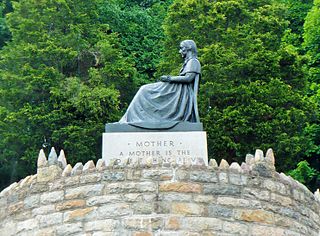
Ashland is a borough in Schuylkill County in the U.S. state of Pennsylvania, 15 miles (24 km) northwest of Pottsville. It is part of Northeastern Pennsylvania. A small part of the borough also lies in Columbia County, although all of the population resided in the Schuylkill County portion as of the 2020 census. The borough lies in the anthracite coal region of eastern Pennsylvania. Settled in 1850, Ashland was incorporated in 1857, and was named for Henry Clay's estate near Lexington, Kentucky. The population in 1900 was 6,438, and in 1940, 7,045, but had dropped to 2,471 at the 2020 census.

Washington Crossing Historic Park is a 500-acre (2 km2) state park operated by the Pennsylvania Department of Conservation and Natural Resources in partnership with the Friends of Washington Crossing Park. The park is divided into two sections. One section of the park, the "lower park," is headquartered in the village of Washington Crossing located in Upper Makefield Township in Bucks County, Pennsylvania. It marks the location of George Washington's crossing of the Delaware River during the American Revolutionary War.

Gloria Dei Church, known locally as Old Swedes', is a historic church located in the Southwark neighborhood of Philadelphia, Pennsylvania, at 929 South Water Street, bounded by Christian Street on the north, South Christopher Columbus Boulevard on the east, and Washington Avenue on the south. It was built between 1698 and 1700, making it the oldest church in Pennsylvania and second oldest Swedish church in the United States after Holy Trinity Church in Wilmington, Delaware.

Ringoes is an unincorporated community and census-designated place (CDP) located within East Amwell Township in Hunterdon County, in the U.S. state of New Jersey. The community is served by the United States Postal Service as ZIP Code 08551 and as of the 2020 United States census, the CDP's population was 849.
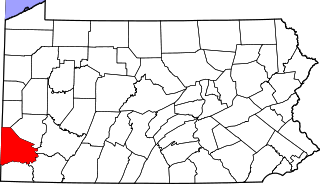
This is a list of the National Register of Historic Places listings in Washington County, Pennsylvania.

Hope Lodge is a historic building located at 553 South Bethlehem Pike in Fort Washington, Pennsylvania, in the United States. This mansion has been described as "one of the finest examples of Georgian Colonial architecture in this part of the country. It was used by Continental troops during the 1777 Philadelphia Campaign during the American Revolution.
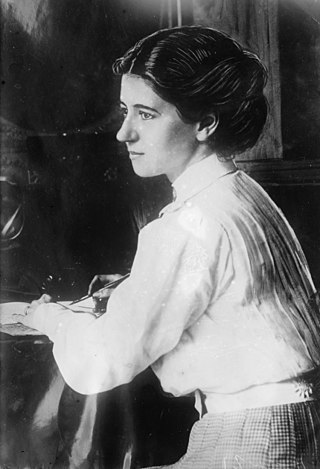
Violet Oakley was an American artist. She was the first American woman to receive a public mural commission. During the first quarter of the 20th century, she was renowned as a pathbreaker in mural decoration, a field that had been exclusively practiced by men. Oakley excelled at murals and stained glass designs that addressed themes from history and literature in Renaissance-revival styles.
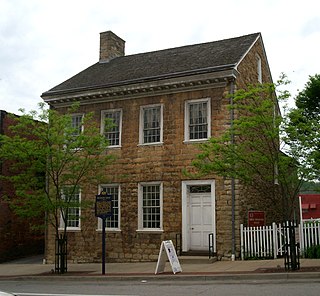
The David Bradford House is a historic house museum at 175 South Main Street in Washington, Pennsylvania. Completed in 1788, it was the home of David Bradford, a leader of the Whiskey Rebellion. It has both architectural and historic importance, and was designated a National Historic Landmark in 1983. It is open weekly between April and November, or by appointment.

Francis Julius LeMoyne was a 19th-century American medical doctor and philanthropist from Washington, Pennsylvania. Responsible for creating the first crematory in the United States, he was also an abolitionist, founder of Washington's first public library, co-founder of the Washington Female Seminary, and an instrumental benefactor to the LeMoyne Normal and Commercial School, to which he made a $20,000 donation in 1870.

The Edward G. Acheson House is a historic house at 908 West Main St. in Monongahela, Washington County, Pennsylvania, United States. Probably built about 1870, it is notable as the home of Edward G. Acheson (1856-1931), the inventor of carborundum, and as the likely site of its invention. It was designated a National Historic Landmark in 1976.

The Simon Cameron House, also known as John Harris Mansion and the Harris–Cameron Mansion, is a historic house museum at 219 South Front Street in Harrisburg, Pennsylvania. Built in 1766 and frequently extended and altered, it is one of Harrisburg's oldest buildings, and is nationally notable as the summer residence of Simon Cameron (1799–1889), an influential Republican Party politician during and after the American Civil War. The house and family items were donated to the Historical Society of Dauphin County in 1941, which now operates it as a museum. The mansion was declared a National Historic Landmark in 1975, and is located in the Harrisburg Historic District.

The F. Julius LeMoyne House is a historic house museum at 49 East Maiden Street in Washington, Pennsylvania. Built in 1812, it was the home of Dr. Francis Julius LeMoyne (1798–1897), an antislavery activist who used it as a stop on the Underground Railroad. LeMoyne also assisted in the education of freed slaves after the American Civil War, founding the historically black LeMoyne–Owen College in Memphis, Tennessee. His house, now operated as a museum by the local historical society, was designated a National Historic Landmark in 1997. It is designated as a historic public landmark by the Washington County History & Landmarks Foundation.
Manada Gap is an unincorporated community in East Hanover Township, Dauphin County, Pennsylvania, United States, located in the Harrisburg-Carlisle area, near Fort Indiantown Gap.

This is a list of the National Register of Historic Places listings in Susquehanna County, Pennsylvania.

John McMillan was a prominent Presbyterian minister and missionary in Western Pennsylvania when that area was part of the American Frontier. He founded the first school west of the Allegheny Mountains, which is now known as John McMillan's Log School. He is one of the founders of Washington & Jefferson College.

Mingo Creek Presbyterian Church and Churchyard is a church and historic location in Washington County, Pennsylvania. It is located at the junction of Pennsylvania Route 88 and Mingo Church Road in Union Township, Washington County, Pennsylvania, near Courtney, Pennsylvania. It is a member of the Washington Presbytery.

The LeMoyne Crematory was the first crematory in the United States. Francis Julius LeMoyne had it built in 1876 on his own land, perched atop a location known locally as Gallow's Hill in North Franklin Township near Washington, Pennsylvania. The first cremation took place on December 6, 1876. LeMoyne believed that cremation was a more sanitary way to dispose of bodies, preventing the contamination of drinking water. After 41 more cremations there, the crematory was closed in 1901. LeMoyne's remains are buried there.
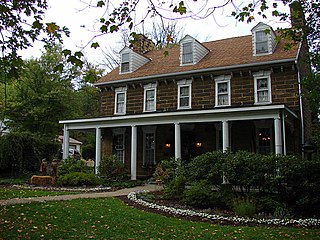
Hill's Tavern is a historic building in Scenery Hill, Pennsylvania. It was heavily damaged by a fire that started shortly before midnight on August 17, 2015. For a period in the early 1900s, the inn was known as Central Hotel. Now called the Century Inn, it has been claimed to have been the oldest tavern in continuous use on the National Road, until the fire brought an end to its 221 years of continuous operation.

The Washington oil field is an oil field and in Washington County, Pennsylvania. It also produced natural gas.



















